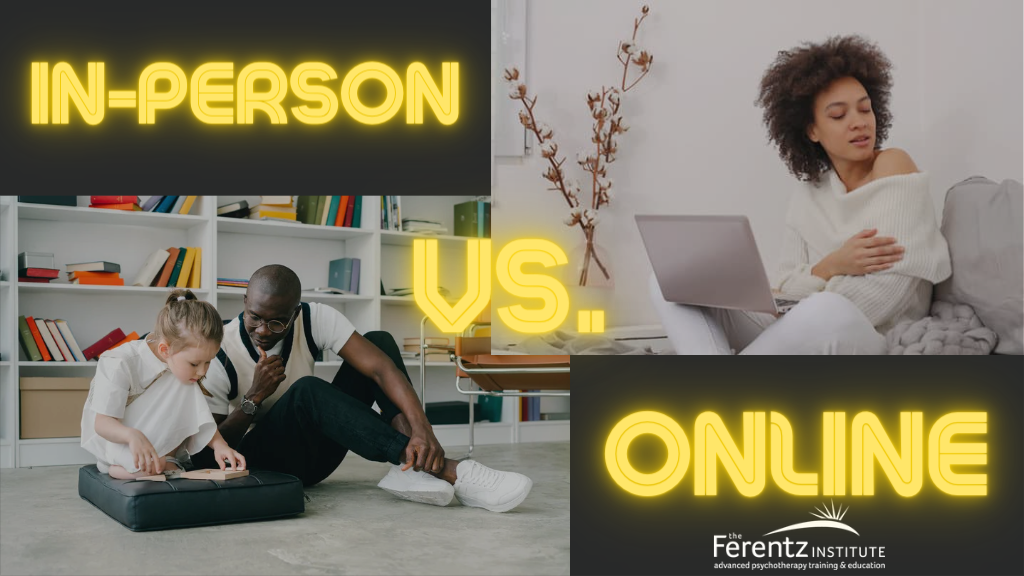
When Covid first began, it took some convincing to encourage clients to transition to tele-therapy. There were concerns that treatment wouldn’t be as effective, wouldn’t feel the same, and the de-personalized experience of talking to a screen would impact what clients were willing to process and share. At the time, we had no choice, and I was grateful the technology existed so clients could continue their work without interruption. I paid for two weeks’ worth of access to an online platform, naively thinking Covid wouldn’t last longer than that. And here we are, three years later, with a new challenge – getting clients back in the office for in-person therapy!
Although I understand that the most common reason why clients are continuing to choose tele-therapy is the “convenience” factor, I am actually surprised by the ongoing reticence to return to in-person sessions. Tele-therapy has been effective, there’s no question about that. But I continue to maintain that, energetically, online therapy is not the same as a face-to-face connection. I’ve also found it more challenging when I don’t get to see the movement and micro- expressions on full bodies. In addition, it’s been harder to incorporate the expressive modalities that I love using, including sand tray, collaging, and movement. I know they can be translated to an online format, but I still believe they work best when I can more palpably hold safe space for my clients and monitor potential triggering in the office.
“We have been a physically disconnected and isolated society for three years and the mental health fallout has been profound.”
It’s a strange conundrum. Clients like doing therapy on their bed with their pet on their lap. I understand the comfort, familiarity, and grounding that can yield. But we have been a physically disconnected and isolated society for three years and the mental health fallout has been profound. Dramatic upticks in anxiety, depression, relapsing, and physical and emotional violence in relationships. I’ve always believed that we are biologically hardwired for connection, and the antidote to the trauma we have all endured for the last three years needs to be reconnecting to people and environments that make us feel seen and safe.
I am resigned to the fact that my practice will continue to be hybrid, but I am also holding out hope that as time goes by, more clients will remember the special and unique experience of in- person therapy sessions and will eventually find their way back to my office.
From your experience, what is your view on continuing hybrid therapy? I’d welcome your thoughts.


I really appreciate the mix. I think it all depends on the client. Telehealth has increased access to services for so many people. And personally, I enjoy both working from home 3 days per week, and working at the office 2 days. It’s a perfect mix for me, the best of both worlds.
Hi Lisa, thanks for your thoughts, and what you wrote. I have recently made the decision to move away from virtual sessions, except in the case of inclement weather, or possible Covid exposure. I agree with everything you wrote, as far as expressive modalities not translating very well, and not being able to see full body language when it’s virtual. I am also finding that it’s very difficult for clients to have good boundaries as far as going back to work right after the session if they are working from home or having to jump right back into their life immediately. While I can still do some grounding and containment virtually, not having the physical container of my office really makes it less effective in my opinion. I have also found it nearly impossible to do EMDR safely/effectively and things like guided imagery, because if they were there in person, I would dim the lights and have the music that they are accustomed to in my office and my familiar couch. I need to see their whole body to watch them breathing and it’s too difficult to set that up virtually. While some clients definitely find it more convenient to do therapy from home, I think that as more and more clinicians move back to doing in person therapy that that will become more of the norm again and if clients want to do therapy then that’s what will be required of them just as it was before the pandemic hit.
I love the points you make in this article. We are built for connection and social creatures. I understand this will take time to slowly build back but I do hope that we can encourage our clients to come back to the in-person experience that I believe cannot be fully replicated online.
I have had a different experience with my clients where the majority of my clients are and prefer in person to a virtual model. In fact of the roughly 20 clietns I see weekly, I have one individual who is seen virtually, while others may use virtual if in a bind. I do agree that I am more effective in person than I am via a screen. The flip side is when I am providing supervision and consultation and groups, I have found a virtual platform helpful. I like reframing this as hybrid model.
I appreciate the points you made in your article, Lisa. Virtual sessions took some time to get used to, but it’s going better than I expected. I’m doing a hybrid right now, although more and more clients are asking for in-person sessions. I am hearing from clients that they have trouble finding therapists who offer in person sessions. Some providers who used to meet in-person have decided to give up their office space and remain 100% virtual. I understand that choice and there are plenty of clients who prefer virtual. But for those who want in-person sessions, it seems to be a struggle right now..